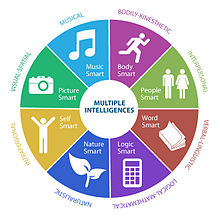
The theory of multiple intelligences (MI) is the pseudoscientific differentiation of human intelligence into specific distinguishable multiple intelligences, rather than defining it as a single general ability. Since 1983, the theory has been popular among educators around the world. In the influential book Frames of Mind: The Theory of Multiple Intelligences (1983) and its sequels, Howard Gardner identifies at least eight distinct intelligences that humans use to survive, thrive and build civilization. The theory describes intelligence as the "brain's toolkit" for creating symbolic thought that is mobilized within one’s specific culture.[1]
While the concept of a unitary or general intelligence (I.Q.) has been controversial since its introduction in the early 1900s,[2] no other multi-intelligence theory has endured to challenge its dominance to the same degree as Gardner’s MI theory.[3] Introduced as a revolutionary psychological construct, it came to be severely criticized by psychologists for its lack of empirical evidence, its dependence on subjective judgement and its overall unscientific nature, being referred to as a “neuromyth”.[4][5]
- ^ Gardner, H. (2024). The essential Howard Gardner on education. New York: Teachers College Press.
- ^ Herrnstein, R.; C., Murray (1994). The bell curve: Intelligence and class structure in American life. New York: The Free Press.
- ^ Schaler, J. A.; Gardner, H. (2006). Howard Gardner under fire: The rebel psychologist faces his critics. Peru, IL: Open Court Publishing. doi:10.5860/choice.44-6524.
- ^ Cite error: The named reference
:0was invoked but never defined (see the help page). - ^ Waterhouse, Lynn (27 August 2023). "Why multiple intelligences theory is a neuromyth". Frontiers in Psychology. 14. doi:10.3389/fpsyg.2023.1217288. PMC 10493274. PMID 37701872.